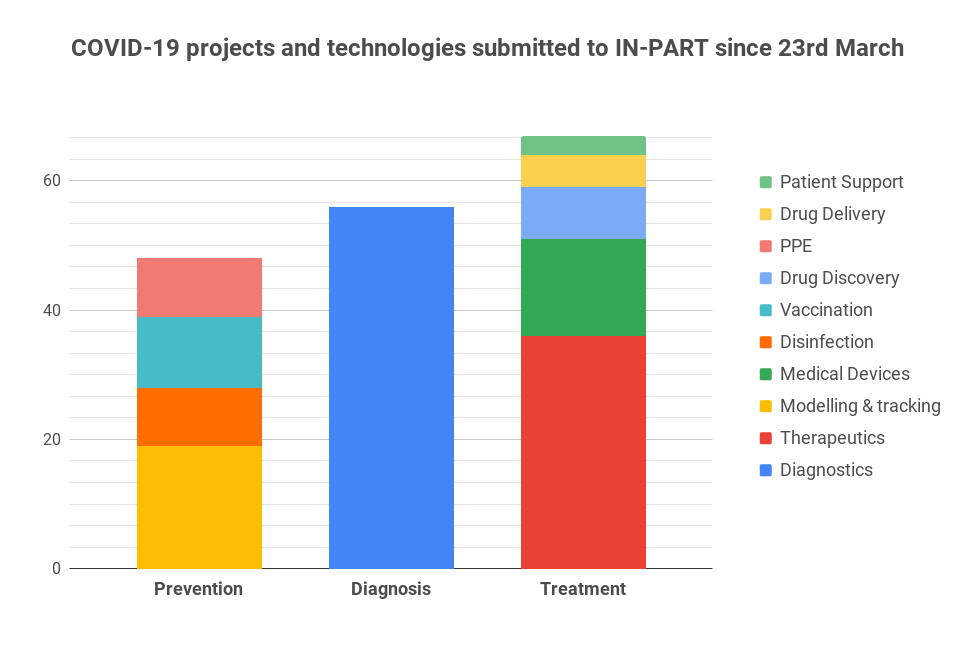In March, with the lockdown imminent, we realised that we needed to do something to support the university-industry community to find solutions, treatments and a vaccine for this new virus. We launched an open call for research and redeployed our teams. The response was rapid. We’ve received 174 submissions from 61 universities across 6 continents, with each submission detailing a new breakthrough or technology being developed by an academic team to stop the spread of SARS-CoV-2 and to treat COVID-19.
These submissions cover everything from responsive antiviral biomaterials (University of Toronto), serological assays (University of Hong Kong) and early warning systems for post-intensive care deterioration (University of Oxford), to point-of-care diagnostics (Cornell University), therapeutic agents (University of Sao Paulo) and first-in-class RNA vaccines (Max Planck Society). A full categorised directory of the submissions can be found in our public directory.
Each project submitted to our call for research was uploaded to our matchmaking platform and our team ran them through the matching process to identify R&D teams from our network of 6,000+ companies with aligned interests. The response from industry followed what we’d seen in academia. Companies rapidly shifted their focus and redistributed their workforce to bring to market solutions to the pandemic building on the latest breakthroughs coming out of university labs.
More from News
- What Influences Bitcoin Prices And Fluctuations?
- World’s First AI Chef To Come This September. Here’s How It Works
- Microsoft Who? Nvidia Has Officially Become the First Company to Surpass a $4 Trillion Market Cap
- Are AI Startups Investing In Teachers Learning AI A Good Move For Education?
- Can a Robot Really Perform Surgery Without Human Help?
- Reports Show Fewer Students Chasing Tech Careers, Here’s Why
- Undersea Cables And Digital Systems At Risk, MPs Warn
- Government Partners With Google Cloud To Modernise Tech, Here’s How
Over 60 conversations are now underway between teams in academia and industry to further develop and deploy the solutions submitted to our call for research. These are being hosted by the likes of Merck, Roche, AbbVie, Ford, Philips, Thermo Fisher and GSK Vaccines, along with many others.
Many of the conversations have now reached the stage at which the academics are involved, NDAs are in place, and the companies are reviewing confidential data and results. With others, academic teams are conducting new experiments to generate the data companies have asked to see before bringing the project in-house for further development.
Due to confidentiality agreements, much of this we can’t share at this stage. But one of these is with a UK-based pharma company seeking results from animal models for a potential oral vaccine that targets the COVID-19 virus-host cell interaction, in development by academics at Colorado State University. Another is a European pharma company requesting further testing of an immunotherapy that could enhance the response of the innate immune system against COVID-19, which is in development by researchers at Bar-Ilan University.
A breakdown of the research and technologies submitted by universities and research institutes to IN-PART’s call for COVID-19 research.So, what happens next? For our academic community, priorities vary. Around half of the technology transfer offices in a recent survey we ran said their top priority for the next few months was about maintaining or getting back to business as normal. For others, it’s going to be about adapting to a reduced workforce, supporting their researcher base, or increasing the volume of industry collaborations at their institute.
There’s little doubt we’re in this for the long run. But the way things are going, I’m backing science to save the day. Improved treatment regimes and new therapeutics will help to reduce the death rate. Advances in tracking and modelling, along with better PPE and transmission suppression, will help to stem the spread of the virus. And a vaccine, or vaccines, given widespread adoption, will eventually confer global protection.



